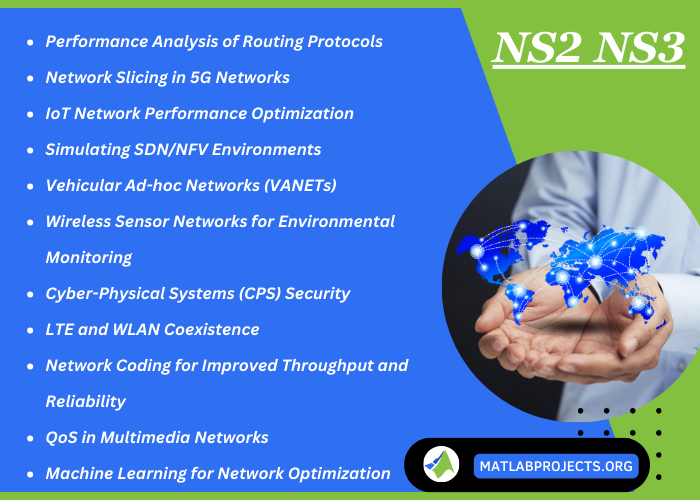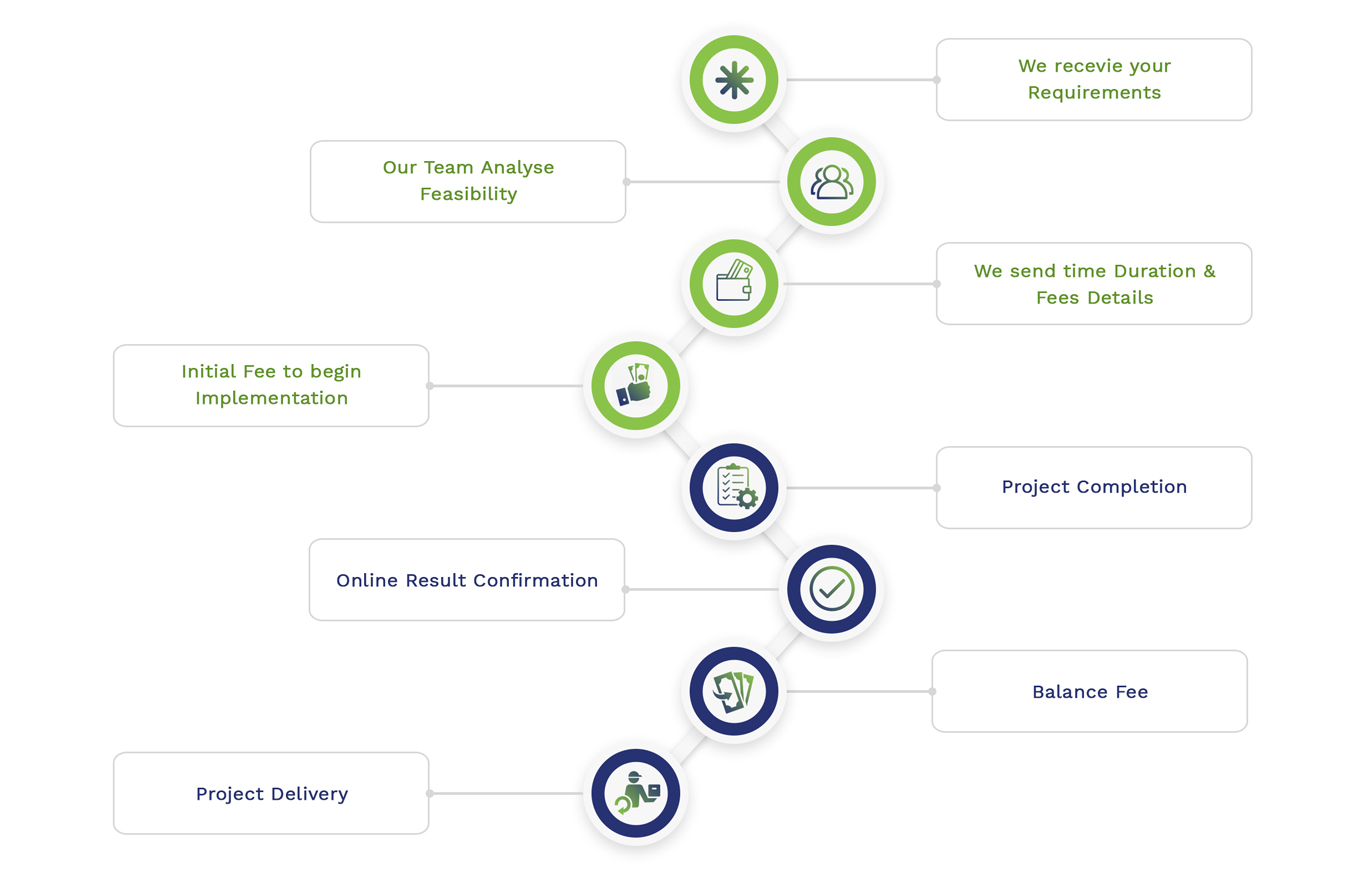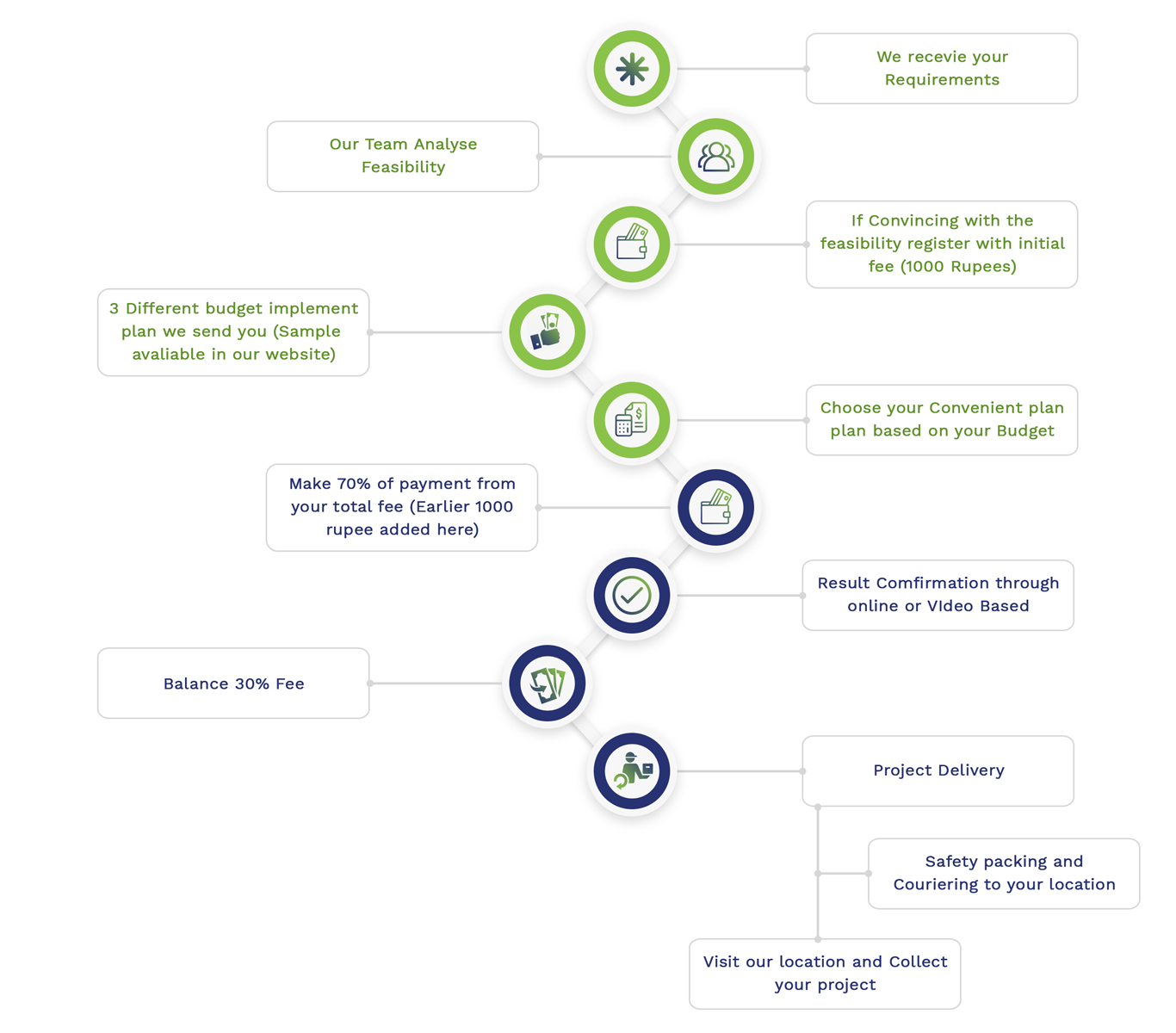It is valuable to concentrate on regions that are of recent passion in the networking committee as well as clearly justified by the simulation platform, while determining project topics and ideas for ns-2 or ns-3. At matlabprojects.org, we have a team of top writers and developers ready to execute your NS2 NS3 projects based on your requirements. The following are numerous project plans that extend a scope of networking theories:
- Performance Analysis of Routing Protocols
- Explanation: By utilizing ns-3, contrast the effectiveness of different routing protocols such as DSR, OLSR, AODV, in various network settings. Mainly, in different settings such as rural, urban, or vehicular networks, this project can concentrate on parameters like delay, packet delivery ratio, and throughput.
- Network Slicing in 5G Networks
- Explanation: Concentrating on the allotment of network resources to various slices on the basis of their necessities, employ ns-3 to simulate network slicing in 5G networks. The effectiveness and efficacy impacts of various slicing policies can be investigated in this study.
- IoT Network Performance Optimization
- Explanation: Determining aspects such as data throughput, scalability, and energy utilization, simulate an IoT network in ns-3 to assess and enhance its effectiveness. Typically, this study has the capability to research the influence of various network topologies and communication protocols.
- Simulating SDN/NFV Environments
- Explanation: To design and simulate Network Functions Virtualization (NFV) and Software-Defined Networking (SDN) platforms, aim to make use of ns-3. The factors like SDN controller effectiveness, the influence of NFV on network efficacy, or safety impacts can be investigated in this research.
- Vehicular Ad-hoc Networks (VANETs)
- Explanation: By employing ns-2 or ns-3, examine the activity and effectiveness of vehicular ad-hoc networks. This study mainly concentrates on topics such as collision avoidance technologies, routing protocols for VANETs, or the incorporation of VANETs with 5G networks.
- Wireless Sensor Networks (WSNs) for Environmental Monitoring
- Explanation: In order to simulate the implementation of wireless sensor networks for ecological tracking applications, it is appreciable to utilize ns-2 or ns-3. Generally, energy preservation policies, data collection approaches, or optimal sensor placement can be investigated in this project.
- Cyber-Physical Systems (CPS) Security
- Explanation: Concentrating on network layer, simulate assaults and securities on cyber-physical frameworks utilizing ns-3. This research has the capability to examine the influence of different safety violations on CPS efficiency and suggest suitable reduction policies.
- LTE and WLAN Coexistence
- Explanation: Specifically, in the platform of LAA (Licenced Assisted Access) and LTE-U (LTE-Unlicensed), aim to employ ns-3 to research the co-occurrence of WLAN and LTE networks. For unbiased spectrum sharing and reducing intervention, this study can assess suitable policies.
- Network Coding for Improved Throughput and Reliability
- Explanation: Particularly, in multicast settings or lossy platforms, deploy network coding approaches in ns-2 or ns-3 in order to assess their influence on network consistency and throughput.
- QoS in Multimedia Networks
- Explanation: For multimedia content delivery beyond IP networks, simulate Quality of Service (QoS) technologies in ns-2 or ns-3. For assuring VoIP services or smooth video streaming, projects can investigate the performance of various QoS approaches.
- Machine Learning for Network Optimization
- Explanation: To enhance network functions like resource allotment, anomaly identification, or congestion management, it is appreciable to incorporate machine learning methods with ns-3 simulations. For deploying machine learning frameworks, this research can manipulate Python bindings of ns-3.
What is the difference between ns2 and ns3?
There are several differences that exist between ns2 and ns3 based on their functionalities and performance. We provide the major variations among ns2 and ns3:
- Implementation Language
- NS-2: Typically, it is deployed in a C++ as well as an interpreted scripting language known as Otcl (Object-oriented Tool Command Language). The arrangements and setting explanations are normally performed in Octl, and the major simulation logic is in C++ for effectiveness, thereby making it little inconvenient to employ.
- NS-3: Along with optional Python bindings, NS-3 is deployed completely in C++. To make it more available for users who are aware of Python, this permits for more reliable efficacy and the opportunity of writing simulation scripts extensively in Python.
- Architecture and Design
- NS-2: Incorporating NS-2 with other software or prolonging it, needs an immersive interpretation of its internal technologies and can be a little complicated. Generally, NS-2 contains a more monolithic pattern.
- NS-3: The API of NS-3 is more reliable and organized, thereby making it simpler to prolong and incorporate with external libraries or applications. The NS-3 was formulated by considering extensibility and modularity.
- Simulation Models and Protocols
- NS-2: Mainly, for previous or more conventional mechanisms, it has a broad scope of protocols and frameworks. Because of the complication of its infrastructure, the process of upgrading these frameworks or appending novel ones is considered as problematic.
- NS-3: Its modular structure enables the inclusion of novel protocols and systems. Normally, it is advanced with recent networking study regions and concentrates on innovative principles and mechanisms such as 4G/5G networks.
- Performance and Scalability
- NS-2: Specifically, for extensive simulations, the partition among Otcl and C++ can influence the effectiveness of simulation.
- NS-3: Along with the enhancements in managing of wide simulations, it is formulated for enhanced scalability and effectiveness. The execution speed can be enhanced by the utilization of simple implementation language (C++) during the process.
- Community and Support
- NS-2: Since the advancement of NS-2 has been widely replaced by NS-3, its committee has slightly decreased, when it is utilized. Normally, the user committee is reduced, while upgrades and assistance are less common.
- NS-3: Together with consistent upgrades and a progressing warehouse of documentation and frameworks, NS-3 contains a more efficient advancement committee and user base. The sources and assistance can be identified in a simpler way by this active community support.
- Learning Curve
- NS-2: As a result of its usage of two various languages and more complicated structure, it contains a steeper learning curve.
- NS-3: Due to its reliable utilization of Python or C++ and good documentation make it a little simpler for novel users to study and utilize, even though it is still complicated.
- Compatibility
- NS-2: Because of the variations in model and infrastructure, scripts and settings that are constructed for NS-2 cannot be directly employed in NS-3.
- NS-3: Typically, simulations have to be rewritten or adjusted to work in NS-3, which is determined as an important responsibility. It is not flexible or adaptable with NS-2.

NS2 NS3 Project Topics & Ideas
Below is a compilation of NS2 and NS3 project topics and ideas that are captivating to readers. We specialize in executing the latest trending projects with exceptional outcomes. Our developers proficiently handle simulations and algorithms. We tailor our work to meet your specific requirements. Entrust us with your manuscript and we will deliver it flawlessly.
- An adaptive medium access control protocol using m-ary tree algorithms for quality-of-service support in single-cell ad hoc networks
- A review of medium access protocols for mobile ad hoc networks with transmission power control
- An intelligent backbone formation algorithm for wireless ad hoc networks based on distributed learning automata
- Bypass routing: An on-demand local recovery protocol for ad hoc networks
- New quantum-genetic based OLSR protocol (QG-OLSR) for Mobile Ad hoc Network
- PDP: A lightweight discovery protocol for local-scope interactions in wireless ad hoc networks
- Rate management in multiuser detection based MAC design for ad hoc networks
- On the construction of energy-efficient maximum residual battery capacity broadcast trees in static ad hoc wireless networks
- An energy efficient teaching learning based optimization approach for common content distribution in mobile ad hoc networks
- An efficient secure distributed anonymous routing protocol for mobile and wireless ad hoc networks
- Clustering in mobile ad hoc networks through neighborhood stability-based mobility prediction
- Integrating service discovery with routing and session management for ad-hoc networks
- MESHMdl event spaces — A coordination middleware for self-organizing applications in ad hoc networks
- An efficient multi-channel MAC protocol for wireless ad hoc networks
- A comparative evaluation of intrusion detection architectures for mobile ad hoc networks
- The slow start power controlled MAC protocol for mobile ad hoc networks and its performance analysis
- A multi-priority supported medium access control in Vehicular Ad Hoc Networks
- Location based transmission using a neighbour aware with optimized EIFS MAC for ad hoc networks
- The Research of a Multiple Disjoint Paths Routing Protocol for Ad Hoc Sensor Networks
- Improving routing performance in wireless ad hoc networks using cross-layer interactions
Subscribe Our Youtube Channel
You can Watch all Subjects Matlab & Simulink latest Innovative Project Results
Our services
We want to support Uncompromise Matlab service for all your Requirements Our Reseachers and Technical team keep update the technology for all subjects ,We assure We Meet out Your Needs.
Our Services
- Matlab Research Paper Help
- Matlab assignment help
- Matlab Project Help
- Matlab Homework Help
- Simulink assignment help
- Simulink Project Help
- Simulink Homework Help
- Matlab Research Paper Help
- NS3 Research Paper Help
- Omnet++ Research Paper Help
Our Benefits
- Customised Matlab Assignments
- Global Assignment Knowledge
- Best Assignment Writers
- Certified Matlab Trainers
- Experienced Matlab Developers
- Over 400k+ Satisfied Students
- Ontime support
- Best Price Guarantee
- Plagiarism Free Work
- Correct Citations
Expert Matlab services just 1-click

Delivery Materials
Unlimited support we offer you
For better understanding purpose we provide following Materials for all Kind of Research & Assignment & Homework service.
 Programs
Programs Designs
Designs Simulations
Simulations Results
Results Graphs
Graphs Result snapshot
Result snapshot Video Tutorial
Video Tutorial Instructions Profile
Instructions Profile  Sofware Install Guide
Sofware Install Guide Execution Guidance
Execution Guidance  Explanations
Explanations Implement Plan
Implement Plan
Matlab Projects
Matlab projects innovators has laid our steps in all dimension related to math works.Our concern support matlab projects for more than 10 years.Many Research scholars are benefited by our matlab projects service.We are trusted institution who supplies matlab projects for many universities and colleges.
Reasons to choose Matlab Projects .org???
Our Service are widely utilized by Research centers.More than 5000+ Projects & Thesis has been provided by us to Students & Research Scholars. All current mathworks software versions are being updated by us.
Our concern has provided the required solution for all the above mention technical problems required by clients with best Customer Support.
- Novel Idea
- Ontime Delivery
- Best Prices
- Unique Work
Simulation Projects Workflow

Embedded Projects Workflow



 Matlab
Matlab Simulink
Simulink NS3
NS3 OMNET++
OMNET++ COOJA
COOJA CONTIKI OS
CONTIKI OS NS2
NS2






